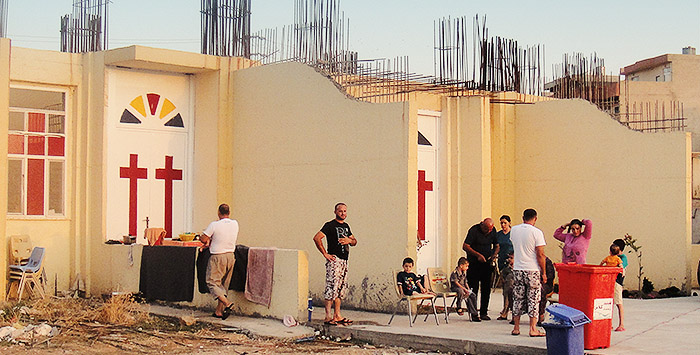
New wave of displacement intensifies need for humanitarian information in Iraq
By Lisbeth Pilegaard, Technical Adviser to IMS on humanitarian information and communication
“ISIL took everything from me. My money, ID papers, my phone, everything. They threatened to kill me if I did not convert to Islam. That’s when I fled.”
Ninos Edvard, a musician from the area around Iraq’s northern city of Mosul, is one among hundreds of thousands recently internally displaced persons (IDPs) in Iraq. Now in the north-eastern city Sulaymaniyah after having first fled to Erbil, he and many others are in dire need of information about access to aid services and updates from relatives who stayed behind in areas taken over by Islamic State (Isis).
Since fighting broke out late last year between Iraqi security forces, Kurdish Peshmerga and armed groups including Islamic State, nearly 1.8 million people have fled their homes across primarily the western and northern parts of the country, according to the International Organization for Migration in Iraq.
Ninos Edvard and 120 other recently internally displaced persons live in the compound of Sulaymaniyah’s Holy Mary Church where a makeshift shelter has been set up. Meeting rooms have been transformed into places for the sick and for children to gather in during the day. People sleep on mattresses on the floor or on church benches in the unfinished chapel.
“All we need is protection, and to return home,” said Sahid Hannatti, a young student, who lives in the church compound. Sahid Hannatti fled on foot with his elderly parents after his village outside of Mosul was captured by Islamic State. They walked at night until they got a lift to Erbil in the early morning. From there, they made their way to Sulaymaniyah.

Sahid Hannatti and Ninos Edvard point to their mobile phones when they explain how they access information.
“We call those that are left behind to check how they are and how the situation is in our villages. If they are damaged, destroyed or if the soldiers have occupied our houses,” said Ninos Edvard.
The younger IDPs in the church compound use the internet to stay informed and to communicate, but they are running out of money for the internet dongle.
“We also watch TV but we have an issue with trusting the news,” said Sahid Hannatti.
Sahid Hannatti and Ninos Edvard might be considered among the more fortunate when compared to the living conditions of many other IDPs who have struggled for months without any kind of shelter acutely aware that winter is approaching with temperatures hovering around freezing point.
800,000 people have been displaced internally in Iraq since August. Like Sahid Hannatti and Ninos Edvard, the majority of them fled heavy fighting between Islamic State and Kurdish Peshmerga in the Sinjar and Mosul areas.
”All eyes are on us now. We need to act and show that we act,” said a senior UN representative at a recent meeting in Erbil on establishing camps to house the new wave of internally displaced persons.
Though camps are not a durable solution to displacement, they can alleviate the burden on public spaces like the Holy Mary Church in Sulaymaniyah and they offer an important immediate solution for the thousands without shelter and access to basic services such as health, food and water.
Widespread lack of information on aid service access
As Sahid Hannatti and Ninos Edvards underline, food and water are not the only needs among Iraq’s new wave of internally displaced. An assessment by five international humanitarian agencies and the U.S.-based media development group Internews carried out in September points to widespread lack of access to reliable news and information from the local media and lack of access to information about existing and planned aid services. Many among Iraq’s ethnic and religious minorities are also looking for information on how to leave the region and seek asylum elsewhere, says the report.
The report echoes several of the findings in an IMS assessment carried out in early 2014 among Syrian refugees in Sulaymaniyah. The refugees pointed to a lack of information about what was going on at home and what they could do to improve their lives while displaced.
IMS is setting up a humanitarian information project in Sulaymaniyah to respond to these information and communication needs. The project will work with local media partners and humanitarian organisations to provide Iraqi IDPs and Syrian refugees with access to humanitarian information.




